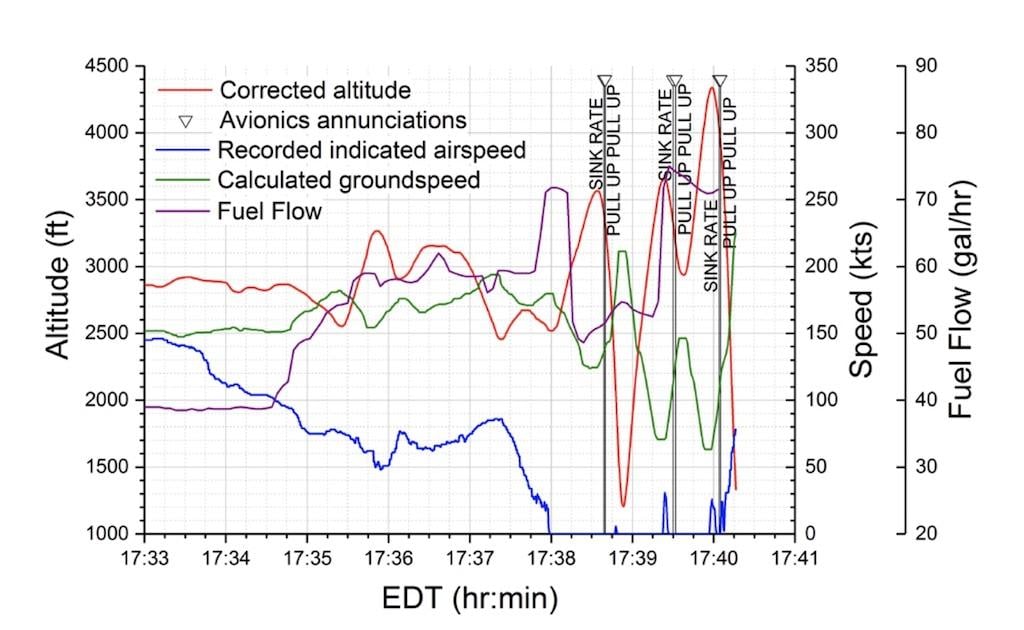
The Avidyne flight data, the meteorologist’s information, and the flight path reconstructed by the performance specialist enabled the NTSB to pretty conclusively show that the experienced pilot lost control of the Cessna 421 because he lost indicated airspeed information in icing conditions. It’s a short step to further conclude the pitot heat was not on.
Why was the pitot heat off? It could have failed. According to an experienced C-421 pilot, the airplane has no panel indication that pitot heat is on, off, or failed. The pilot could have had pitot heat on but wasn’t aware it failed. However, since the airplane had just been through an annual inspection, this seems unlikely.
It seems more likely the pitot heat switch was off. C-421 pilots leave the heat off until they are in flight to prevent overheating the probe. That means they must remember to turn it on when approaching icing conditions. In addition, the pitot heat switch is located on a left side panel under the pilot’s left elbow, and it is not particularly prominent. Looking down and left to move the switch could disorient a pilot who is hand flying the airplane on the gages.
Pitot Heat Switch

Since the 1968 advent of the C-421, probe and sensor heat technology has advanced. It is common for the heat function to be automatically actuated. On the Airbus A320, for example, sensor heat is activated at engine start. It is possible the accident pilot had not turned on a pitot heat switch on any airplane for years.
The pilot’s actions when the airspeed began to fall off showed he misinterpreted what was happening. He added power in an effort to offset apparent structural icing, but more power was not needed. After the power increased, the airplane began to climb, and when the pilot pulled power off, it descended. He was never able to stabilize on an appropriate pitch attitude or power setting, so the altitude oscillations got worse.
If the autopilot altitude hold feature had been engaged and remained engaged, it could have prevented the climbs and descents. It appears, however, based on small altitude deviations during the initial cruise portion of the flight, that it was not engaged. Furthermore, most unreliable airspeed procedures require that autopilot, autothrottle (if installed), and flight director be disengaged as initial steps in the recovery.
Knowing the appropriate pitch attitude and power setting for the existing phase of flight is crucial. Unfortunately, most pilots don’t know them. An article in SKYbrary makes the point that pilots flying highly automated aircraft who are accustomed to using the Flight Path Vector are often unable to state those numbers accurately.
Manufacturers such as Airbus have devised Flight with Unreliable Airspeed procedures in recent years and these procedures have become commonplace in airline flight manuals. The procedures vary because aircraft systems vary, but the common denominator to all of them is knowing the right pitch attitude and power setting for any given phase of flight.
In a December 2007 edition of Airbus’ Safety First magazine, a flight operations engineer discussed that company’s recommended procedure for the A320. The memory items assume the airplane is at a critical altitude or phase of flight. After disconnecting the autopilot/flight director and autothrust, specific pitch attitudes and power settings are prescribed. Right after takeoff, for example, the required pitch attitude is 15 degrees and the power setting is TOGA (takeoff/go-around).
Once an appropriate altitude is reached, follow-up items are to set pitch and power for level flight from a matrix in the abnormal procedure. At a midlevel gross weight, below FL 240, and in a clean configuration, for example, the target pitch attitude to maintain 250 kt is 2.1 degrees and the thrust setting is 60.7% N1.
Trying to fly without the airspeed indictor is something we rarely experience. The partial panel training we do in initial instrument training usually involves an instructor covering the attitude and heading indicators to simulate vacuum failure. Even in more advanced aircraft like tactical fighters and commercial airliners, emphasis is often placed on redundant sources of flight information like groundspeed and attitude information rather than flying pitch and power.
For airplanes that lack an unreliable airspeed procedure, a little time observing and writing down the nominal pitch and power settings for climb, cruise, descent and fully configured approach would be time well spent. It will improve your day-to-day instrument flying and it may save your life someday.
A Flight With Unreliable Airspeed, Part 1 https://aviationweek.com/business-aviation/safety-ops-regulation/flight…





